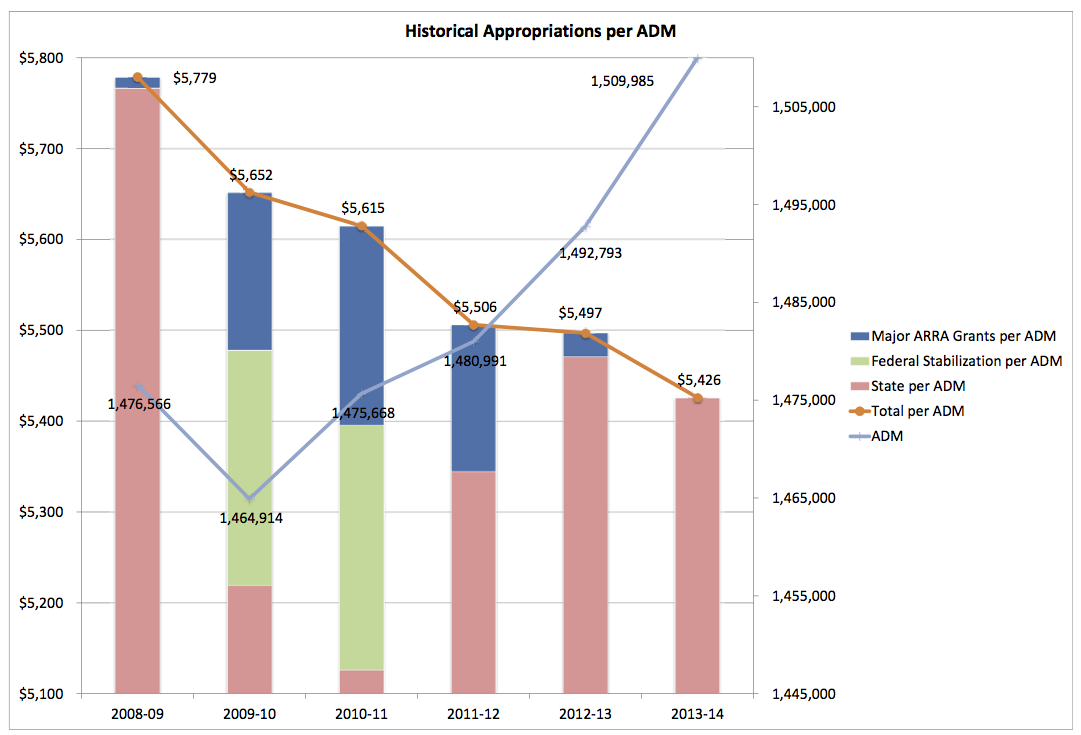This chart by the N.C. Department of Public Instruction shows the per pupil spending trend since 2008, compared to the growth in the student population over the same time period.
Confused by competing political claims over public school funding in the recently approved North Carolina budget? The N.C. Department of Public Instruction prepared an analysis with the aim of clarifying the budget’s impact on schools. Here’s the report:
Analyses of 2013-15 Budget for Public Schools
NC Department of Public Instruction – August 2013There are a lot of numbers swirling around in relation to the 2013-15 biennial budget recently approved by the NC General Assembly and signed by the Governor. It is easy to be uncertain about the impact of this budget on schools. Some of that confusion is based on people using different numbers to make comparisons.
Based on the North Carolina Department of Public Instruction’s (NCDPI) analysis, public schools received 2.9 percent less than they expected to receive based on the Continuation Budget’s existing allotment formulas and growth in the number of students and in the needs of those students. (The Continuation Budget refers to the budget that is already in place from one year to the next. It provides an essential baseline to which the legislature makes changes each session.)
North Carolina public schools are expecting more students and more students with special needs for the 2013-14 school year. In past years, school districts could expect to receive a certain amount of funding to support those students. The new budget falls short of that need.
NCDPI’s Calculations
Governor’s ContinuationBudget: $7,984,924,757 (district expectation)
Final Budget: $7,865,960,649 (what was funded)
Difference: $118,964,108 (a reduction of 1.5 percent)The one-time (non-recurring) cuts made in 2012-13 to textbooks and instructional supplies were not restored to the budget in 2013-14. This took an additional $76.5 million in textbook funds and an additional $38.4 million in instructional supplies out of the public school budget.
You can see the impact here:
Governor’s Continuation
Budget: $7,984,924,757Add back in the 2012-13
One-time cuts: $76,500,000 (Textbooks)
$38,417,147 (Inst. Supplies)
$8,099,841,904Actual Conference Budget: $7,865,960,649
Difference: $233,881,255 (a 2.9 percent reduction)
What about the 4.8 percent increase in public school funding? Where does that number come from?
This percentage is from a comparison between the FY 2012-13 Budget Money Report with this year’s Budget Money Report ($7,865,960,649 vs. $7,506,553,067) — a 4.8 percent increase. The 4.8 percent increase reflects increases in the state retirement contribution, hospitalization costs, and the 1.2 percent pay increase that was provided to teachers and public school personnel in 2012-13 but not placed in the public school fund at that time. These three things make up $259 million of the 4.8 percent “increase” in the public school fund, but these dollars are either not new to schools or represent status quo funding only, and will not go to support the additional services or personnel needed to help students learn.The Governor’s Continuation Budget and the final budget also restored $72 million to line items that were over-expended (longevity, workers comp, unemployment, etc.). This restoration also explains part of the difference in the two Money Reports.
Finally, the public schools’ student population grew by 17,192 students. So, without going line item by line item, the simple comparison between Money Reports from last year and this year would indicate a difference of $359,407,582, or 4.8%.
When you take that amount and back out the salary and benefit changes for FY 2012-13 ($259 million) and the coverage for over-expended line items ($72 million), you are left with $28 million to serve 17,192 more students. By the way, the actual cost to serve these new students is more than $5,400 each but the amount provided in this budget is far lower, $1,629 per student.
Comparison of 2013-15 Budget to Past Budgets
The state provides funds to public schools by using a combination of state appropriations and receipts. If you consider all state fund sources – appropriations plus receipt dollars from sales tax, fines and forfeitures and lottery funds – dollars are down while the number of students is up.Several years ago, the General Assembly began removing General Fund appropriations and replacing them with funds from receipts from sales tax, fines and forfeitures, and lottery funds. To local school districts and charter schools, it is all just state funds. So, when the total funding including these receipt sources is considered, in 2008-09 the total funding for public schools from state sources was $8,515,669,028. In 2013-14, the total funding from state sources is $8,233,098,909. That reflects $282,570,119 fewer dollars for public schools. Since 2008-09, public schools have grown by 33,419 students.
In addition, Buncombe County Schools Superintendent Dr. Tony Baldwin recently shared his own thoughts on the N.C. budget here.



Before you comment
The comments section is here to provide a platform for civil dialogue on the issues we face together as a local community. Xpress is committed to offering this platform for all voices, but when the tone of the discussion gets nasty or strays off topic, we believe many people choose not to participate. Xpress editors are determined to moderate comments to ensure a constructive interchange is maintained. All comments judged not to be in keeping with the spirit of civil discourse will be removed and repeat violators will be banned. See here for our terms of service. Thank you for being part of this effort to promote respectful discussion.